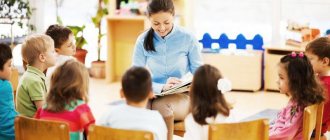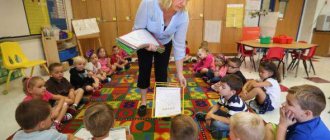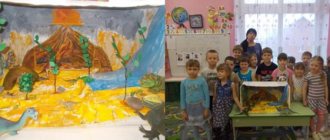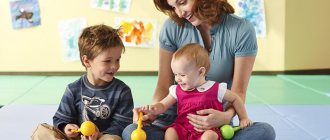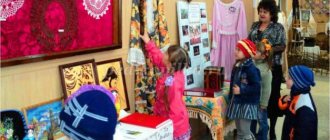Self-education plan for preschool teacher
Teacher self-education plan
Topic: “Development of children's creativity through folk arts and crafts” Compiled by teacher: Evdokimenko Svetlana Nikolaevna Dmitrov Purpose. To develop a child’s creative abilities through introducing him to Russian folk applied art. Tasks. — Study scientific, educational and methodological literature on the issue of Russian folk crafts. - Study the experience of other teachers - specialists in this field. — Use the experience gained in working with children. Relevance. Decorative and applied arts open up to the child a colorful world of folk imagination and a variety of folk crafts.
Folk art cultivates an aesthetic sense in children and evokes a desire not only to admire the works of folk artists, but also to try to make something similar with their own hands, and forms a creative approach to arts and crafts. The child’s brain activity is figurative, colorful, rich in sensations, sounds and shapes, as K.D. said. Ushinsky, that’s why folk art makes such a vivid impression on a child. Familiarization with works of folk art evokes in children the first ideas about their Motherland, its culture, contributes to the education of patriotic feelings, and introduces them to the world of beauty. Arts and crafts classes for children in a preschool also help the child develop technical skills in painting various objects, which directly develops fine motor skills of the fingers, color perception, and improves the child’s oculomotor function. Through arts and crafts classes, children develop a variety of abilities - both artistic and intellectual. 2015-2016 academic year Topic: “Clay folk toy”
Working with children, working with parents, interaction with specialists.
September
1. Conversation with children on the topic “Clay folk toy.” Goal: to continue to introduce children to the history of folk crafts. Learn to distinguish between folk crafts (Khokhloma, Dymkovo, Filimonov products) View a computer presentation “Clay folk toy” 2. Determine in the group a place for a corner for decorative drawing, a circle “Russian patterns”. 3.Drawing: “Pattern on a strip” Purpose: To introduce children to the law of symmetry and the peculiarities of constructing an ornament in a rectangular shape 4.Making a screen for parents “clay folk toy”. 5 Conversation with parents on the topic: “The educational significance of folk toys.” 6. Interaction with the music director: singing Russian folk songs 7. Interaction with the physical education instructor: learning Russian folk outdoor games.
October
1.Designing a corner for the decorative drawing circle “Russian Patterns” 2.Viewing the computer presentation “Filimonovskaya toy”, talking about its history, discussing the individual characteristics of the Filimonovskaya toy. 3. Examination of albums with illustrations of Filimonov’s ornaments and whistle toys. 4.Drawing with children. Topic: "Filimonov's joy." Goal: To teach children to draw perpendicular, parallel and inclined stripes, broken lines and Christmas trees with the tip of a brush. 5. Manual labor: decorating Filimonov toys with woolen threads. 6. Consultation for parents on the topic: “The importance of decorative drawing for the development of fine motor skills of the fingers and improving oculomotor function in children.” 7. City competition for children together with parents “Folk Toy”. Nominations: 1. clay toy 2. sewn from fabric. 8. Interaction with a speech therapist: “Folk nursery rhymes for speech therapy exercises with children” 9. Master class for manual labor teachers: “Use of woolen threads to decorate Filimonov toys”
November
1.Drawing “Multi-colored ornaments”, “Pattern on the carpet”, “Filimonov flowers”. Goal: to consolidate the ability to rhythmically arrange the Filimonov pattern on a strip. Improve technical skills and brushwork skills. 2.Applique: cutting out a rural beauty from cardboard. 3.D.i. “Continue the pattern”, “What has changed?” 4.Drawing “Rural beauties”. Goal: Learn to paint the silhouette of the Filimonovskaya young lady. Secure the drawing of elements - herringbone, stripes, flower - with the tip of the brush. Foster a love of folk art. 5. Making a folder - “movement” “Filimonovsky miracle”. 6. Conversation with parents: “The importance of decorative drawing for a child” 7. Interaction with a speech therapist: Conducting a lexical and grammatical lesson with children using Russian folk art.
December
1. Preparation for the musical entertainment “Winter Gatherings”. 2. Learning finger gymnastics “House” 3. Drawing “Chicken - Corydalis”. Goal: To teach children how to paint a chicken with Filimonov painting. Develop the ability to work independently. Drawing: “On the Farm.” Goal: To teach children to paint traditional forms of Filimonov animal toys. To consolidate knowledge about the compositional arrangement of the Filimonov pattern in various forms. Cultivate accuracy in work. 4.Consultation for parents: “Drawing technique of Filimonov painting.” 5. Conversation with parents: “Why is it important for a child to know a folk toy?” 6. Help from parents in making attributes for the musical entertainment “Winter Gatherings” 7. Interaction with the music director: preparation for the musical entertainment “Winter Gatherings”. 8. Interaction with the physical instructor. culture: learning Russian folk games: “Burners”, “Wicketwork”, “Owl and the Birds”.
January
1.Musical entertainment for parents “Winter Gatherings”. 2. Drawing the collective composition “Merry Holiday”. Goal: to teach children to use previously acquired knowledge and skills about Filimonov painting. Improve the ability to create a composition from elements using familiar silhouettes - herringbone, stripes, flower. Foster initiative, independence, and activity. 3. Memorization of the poem “The Miracle of Filimonov’s Whistles” 4. P. and “Burners” 5. Final exhibition of works on decorative drawing “Filimonov’s Toy”. 6. Competition “Draw and Play”. Parents and children make cut-out pictures depicting clay folk toys. 7. Consultation for parents: “Russian folk games with preschool children” Purpose: To introduce parents to Russian folk games, to show their accessibility for children, to recommend using them in organizing leisure time with children. 8. Practical seminar for educators “Russian folk games with preschool children” Purpose: To introduce and interest teachers in Russian folk games, show their accessibility for preschool children, and recommend using them in working with children. 9. Interaction with a psychologist: “The place and role of folk games in the socialization of children”
February
1. A conversation about the origin of the “Dymkovo Toy”, consideration of the features of the ornaments and colors of the products. 2.Reading the legend: “Where did the signs in drawing come from?” 3.Memorizing physics. minutes “Dymkovo Toys” 4.D.i. “Guess what kind of painting” 5. Drawing: “Dymkovo patterns”, “Madam - lady”, “Duck with ducklings”, “Turkey tail”. Purpose: To introduce children to the creation of a Dymkovo toy and the sequence of actions. Cultivate interest in folk arts and crafts. 6. Russian folk game “Towns” 7. Parents’ meeting on the topic: “Aesthetic education of children through arts and crafts” 8. Making a screen folder “Dymkovo toy” 9. Parents’ help in decorating a corner for decorative drawing “Russian patterns”. 10. Workshop for teachers “Dymkovo toy”.
March
1.Reading a Russian folk tale about the hero Ivan 2.Drawing: “The Master”, “The Lady’s Outfit”, “The Goat”. Goal: To teach children to paint patterns on a silhouette toy based on folk (Dymkovo) motifs. Use different painting elements (straight lines, wavy lines, dots, rings, circles, ovals). 3. Modeling of the Dymkovo lady. 4.D.i. “Recognize the elements of the pattern” 5.P.i. “Wattage” 6. Entertainment in decorative and applied arts “On a visit to the colors” (in a group together with parents) 7. Open lesson for teachers “Fairy-tale Dymkovo country”
April
1.Reading poems about the Dymkovo toy. 2. Painting of the Dymkovo lady. 3.Applique: blank silhouettes of Dymkovo toys. 4.Drawing: “Goat” Purpose: To teach children to paint a silhouette toy with patterns based on folk (Dymkovo) motifs. 5.D.i. “Cut pictures” 6. Final integrated lesson: “Dymkovo toys” 7. Final integrated lesson: “Dymkovo toys” (for parents). 8. Consultation for teachers: “Folk art as the beginning of studying one’s country” 9. Master class for teachers “Using the quilling technique to decorate Dymkovo toys.
May
1.Design of the final exhibition of works on decorative drawing.
2. Entertainment “Dymkovo Fun” 3. Questioning of parents: “Reviews and suggestions for the decorative drawing circle “Russian Patterns.” 4. Speech at the final pedagogical council: “Development of a child’s creative abilities through arts and crafts.” List of studied literature. 1. Averyanova A.P. Visual activities in kindergarten (classes). Mosaic - Synthesis, 2001. 2. Averyanova A.P. Visual activities in kindergarten (classes). Moscow, Mosaic - Synthesis, 2001. 3. Alekhin A.D. Matryoshka dolls. Picture book. Moscow. 1988. 4. Aleksakhin N.N. Blue fairy tale. Moscow. Public education, 1996. 5. Aleksakhin N.N. Magic clay. Moscow. Agar, 1998. 6. Bezrukikh M.M. Sensorimotor development of preschool children in fine arts classes. Moscow. Humanitarian Publishing House, 2001. 7. Boguslovskaya I.Ya. Russian clay toy. St. Petersburg 1975. 8. Gribovskaya A.A. Acquaintance with Russian folk arts and crafts and decorative drawing, modeling, applique by Muscovite preschoolers. Moscow. MIPCRO, 1999. 9. Gribovskaya A.A. Collective creativity of preschool children. Moscow. Creative Center Sphere, 2005. 10. Grigorieva G.G. Visual activity. Moscow. Academy, 1998. 11. Doronova T.N. Preschoolers about art. Moscow. Education, 1998. 12. Doronova T.N. Nature, art and visual activities for children. Methodological recommendations for educators working with children 3-6 years old under the Rainbow program. Moscow. Education, 1999. 13. Doronova T.N. Nature, art and visual activities for children. Moscow. Education, 2000. 14. Zhalova S. Khokhloma paintings. Moscow. Children's literature, 1991. 15. Zhigalova S. Paintings of Khokhloma. Moscow. Children's literature, 1991. 16. Kazakova T.G. Visual activity and artistic development of preschool children. Moscow. Pedagogy, 1983. 17. Kazakova T.G. Develop creativity in preschoolers. Moscow. Education, 1985. 18. Korabelnikov V.A. We draw an ornament (according to the method of E.G. Kovalkovskaya). Moscow. FMIZH, 1993. 19. Knyazeva O.L., Makhaneva M.D. Introducing children to the origins of Russian folk culture. St. Petersburg Childhood-Press, 1998. 20. Klienov A.P. Folk crafts. Moscow. White City, 2002. 21. Korchalovskaya N.V. Comprehensive classes to develop the creative abilities of preschoolers. Moscow. Phoenix, 2003. 22. Komarova T.S. Folk art in the education of preschool children Moscow. Pedagogical Society of Russia, 2005. 23. Komarova T.S. Children in the world of creativity. Moscow. Mnemosyne, 1995. 24. Komarova T.S. Visual arts classes in kindergarten. Moscow. Education, 1991. 25. Komarova T.S. Visual activities in kindergarten: training and creativity. Moscow. Pedagogy, 1990. 26. Komarova T.S. How to teach a child to draw. Moscow, Century, 1998. 27. Komarova T.S., Zyryanova O.Yu. Beauty. Joy. Creation. GOU Primary school – kindergarten No. 1607. 1999. 28. Koromyslov B.I. Zhostovo painting. Moscow. Fine arts, 1997. 29. Mosin I.G. Drawing. For teaching children in families, kindergartens. Ekaterinburg. U - Factory, 1996. 30. Labunskaya G.V. Artistic education in the family. Moscow. Pedagogy, 1970. 31. Mayorova K., Dubinskaya K. Russian folk applied art. Moscow. Russian language, 1990. 32. Utrobina K.K., Utrobin G.F. Fun drawing using the "poke" method with children. Moscow. Gnom i D, 2001. 33. Pansheleev G.N., Maksimov Yu.V., Pansheleeva L.V. Decorative arts for children. Moscow. Education, 1976 34. Popova O.K., Kaplan N.N. Russian artistic crafts. Moscow. Light and food industry, 1984. 35. Razina T.M. Russian folk art. Moscow. 1993. 36. Rondeli L.P. Folk arts and crafts. Moscow. 1984. 37. Skorolupova O.A. Introducing preschool children to Russian folk arts and crafts. Moscow. Scriptorium, 2003. 38. Solomennikova O.A. The joy of creativity. Moscow. Mosaic-synthesis, 2005. 39. Tikhonova M.V., Smirnova N.S. Introducing children to Russian folk art, crafts, and everyday life in the kindergarten museum. St. Petersburg Childhood - Press, 2000. 40. Timofeeva M.V., Tarabarina T.I. And study, and play, and fine arts. Yaroslavl. Academy of Development, 1997. 41. Tyufanova I.V. Workshop of young artists. St. Petersburg Childhood-press, 2002. 42. Fedotov G.Ya. Obedient clay. Moscow. AST - Press, 1997. 43. Shvaiko G.S. Visual arts classes in kindergarten (senior group). Moscow. Humanitarian Publishing Center Vlados, 2001. 44. Shvaiko G.S. Visual arts classes in kindergarten (preparatory group). Moscow. Humanitarian Publishing Center Vlados, 2001. 45. Shibanova N.Ya. Folk art in children's creativity. Khokhloma. Permian. Perm Institute for Advanced Training of Education Workers, 2002. 46. Shpikalova T.Ya. Art. Fundamentals of folk and decorative arts. Educational visual aid for 1st grade. Album. Moscow. Mosaic-Sintez, 1996. 47. Shpikalova T.Ya. Folk art in decorative drawing lessons. Moscow. Education, 1979. 48. Shpikalova T.Ya. Fine arts: Fundamentals of folk and decorative arts. Moscow. Mosaic-Synthesis, 1996.
We recommend watching:
On indicators of professional competence and performance of a teacher Expert opinion on the certification of teaching staff Certification of a teacher Application for certification of a teacher for the first category
Similar articles:
Teacher self-education
How to choose a topic for self-education?
There are only two main criteria:
- requirement to study the topic from the outside (formulated in regulatory documents, in particular, in the Federal State Educational Standard for Preschool Education);
- the work of the teacher himself (lack of experience and knowledge to resolve a particular pedagogical situation).
Thus, before choosing a topic, you need to familiarize yourself with the regulatory framework for preschool education and analyze your own experience.
According to the Federal State Educational Standard, a preschool child develops in the following areas:
- social and communicative;
- educational;
- speech;
- artistic and aesthetic;
- physical.
